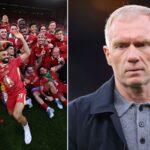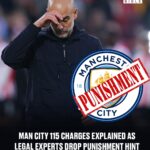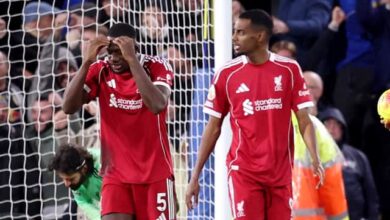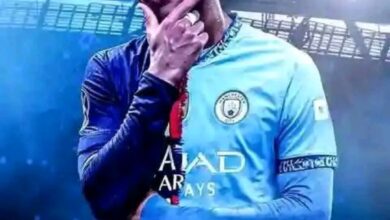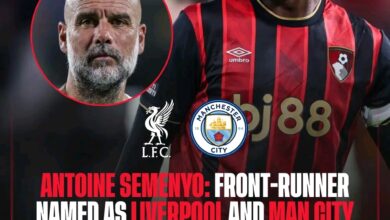Paul Scholes says Man City really messed up by not signing ‘phenomenal’ Liverpool player
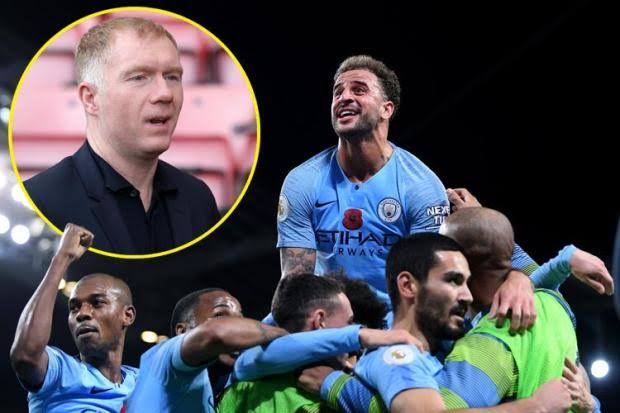
In the unforgiving world of elite football transfers, where decisions worth tens of millions can define a club’s trajectory for years to come, Manchester City’s choice to walk away from Virgil van Dijk in January 2018 stands as one of the most consequential transfer missteps in recent Premier League history. Paul Scholes, the legendary Manchester United midfielder turned pundit, has delivered a damning verdict on City’s decision, describing it as a monumental error that not only cost them one of the world’s finest defenders but handed their bitter rivals Liverpool a transformative signing that would reshape the balance of power in English football.
The winter of 2018 marked a pivotal moment in modern football history, though few recognized its significance at the time. Virgil van Dijk, Southampton’s towering Dutch center-back, had established himself as one of Europe’s most coveted defensive talents. His combination of physicality, technical ability, and leadership qualities had attracted attention from across the continent, but it was the intense battle between Manchester City and Liverpool that would ultimately determine the defender’s destination.
At the heart of this transfer saga lay a fundamental philosophical difference between two of England’s most ambitious clubs. Manchester City, fresh from their record-breaking Premier League triumph under Pep Guardiola, approached the market with their characteristic blend of ambition and calculated restraint. Liverpool, meanwhile, were willing to break their transfer record and commit unprecedented resources to secure a player they believed could transform their defensive capabilities and, by extension, their entire team’s prospects.
The £75 million price tag attached to van Dijk’s signature represented more than just a substantial financial commitment – it was a statement of intent that would separate the clubs willing to take calculated risks from those who preferred to operate within more conservative parameters. As events would unfold, this distinction would prove decisive not only for the player’s career but for the fortunes of both clubs involved in the pursuit
During a recent episode of The Overlap Fan Debate, the discussion turned to Manchester City’s pattern of withdrawing from high-profile transfer pursuits when financial demands exceed their predetermined thresholds. The conversation, sparked by City’s decision to pull out of the race for Bayer Leverkusen’s Florian Wirtz due to similar concerns about the required investment, inevitably led to comparisons with their approach to the van Dijk situation seven years earlier.
Jamie Carragher, Liverpool legend and co-host, drew parallels between the two scenarios, noting how City’s financial prudence, while generally serving them well, had potentially cost them two generational talents. A Manchester City supporter on the panel acknowledged the pattern, referencing the club’s documented tendency to step back from “mega deals” when the numbers don’t align with their strategic framework.
It was at this moment that Scholes delivered his unequivocal judgment: “That was a mistake.” The simplicity of his statement belied the complexity of the situation, but his conviction was unmistakable. For a pundit known for his measured assessments and reluctance to engage in hyperbole, such a definitive stance carried significant weight.
Scholes’ perspective is particularly valuable given his unique position as someone who understands both the pressures of elite-level football and the long-term implications of transfer decisions. His playing career at Manchester United provided him with firsthand experience of how individual signings can alter the competitive landscape, while his punditry work has given him the analytical distance necessary to assess such decisions objectively.
The former England international’s assessment wasn’t merely based on van Dijk’s subsequent performances for Liverpool, though they certainly supported his argument. Instead, it reflected a deeper understanding of how transformational players can impact not just their own teams but entire leagues. Van Dijk’s arrival at Anfield didn’t just improve Liverpool’s defense – it fundamentally altered their tactical approach, their confidence levels, and their ability to compete at the highest level.
The inner workings of Manchester City’s decision-making process regarding van Dijk were laid bare in the club’s edition of Amazon Prime’s “All or Nothing” documentary series. The behind-the-scenes footage provided unprecedented insight into how one of football’s most successful modern clubs approaches major transfer decisions, revealing both the methodical nature of their operations and the potential limitations of their approach.
Chairman Khaldoon Al Mubarak’s reaction to Southampton’s asking price was captured in telling detail. His response – “Come on, you cannot be serious” – encapsulated the club’s incredulity at the financial demands being made for the Dutch defender. The footage showed a leadership team genuinely taken aback by the scale of investment required, highlighting how even the wealthiest clubs in world football must grapple with questions of value and sustainability.
Al Mubarak’s subsequent comments revealed the philosophical framework that guides City’s transfer strategy: “Ultimately, if it makes sense for us we will do it. If it doesn’t make sense, we are perfectly comfortable in walking away. To do that, there’s only a few clubs in the world that can do that.” This statement illuminated both the confidence and the potential blind spots in City’s approach to the transfer market.
The chairman’s emphasis on the club’s ability to walk away from deals – a luxury he correctly identified as being available to only a select few clubs globally – demonstrated the strategic thinking that has generally served City well. However, it also highlighted how this very strength could become a weakness when dealing with genuinely transformational players whose impact might justify seemingly excessive price tags.
The documentary footage also revealed the internal discussions and deliberations that preceded the final decision. City’s recruitment team had clearly identified van Dijk as a player who could improve their squad, but the financial modeling and strategic planning that formed the backbone of their decision-making process ultimately pointed toward withdrawal from the pursuit.
The years following van Dijk’s arrival at Liverpool have provided compelling evidence for Scholes’ assertion that City made a significant error. The Dutch defender’s impact at Anfield has been nothing short of transformational, validating every penny of the £75 million investment and arguably making it appear remarkably good value in hindsight.
BBC pundit Stephen Warnock’s description of van Dijk as “phenomenal” represents the consensus view among football analysts and observers. The 33-year-old’s list of achievements since joining Liverpool reads like a masterclass in elite-level performance: Premier League winner, Champions League victor, UEFA Player of the Year, PFA Player of the Year, and consistent inclusion in team of the year selections across multiple competitions.
However, van Dijk’s true value extends far beyond individual accolades and team trophies. His presence has fundamentally altered Liverpool’s tactical setup, allowing Jurgen Klopp to implement a more aggressive, high-pressing style of play secure in the knowledge that any defensive vulnerabilities could be mitigated by van Dijk’s exceptional reading of the game and recovery pace. This tactical evolution has been central to Liverpool’s success across multiple competitions and seasons.
The psychological impact of van Dijk’s presence cannot be understated. His teammates have frequently spoken about the confidence his presence instills, both in training and during matches. This intangible quality – the ability to make those around him perform better – represents one of the hallmarks of truly elite players and helps explain why his transfer fee, initially seen as excessive, has proven to be exceptional value.
Van Dijk’s injury record and consistency have also validated Liverpool’s investment. Despite the physical demands of Premier League football and the intensity of Liverpool’s playing style, he has maintained remarkably high performance standards across multiple seasons. His ability to perform at peak level in crucial matches – from Champions League finals to title-deciding Premier League encounters – has demonstrated the kind of clutch mentality that separates good players from great ones.
Manchester City’s decision to withdraw from the van Dijk pursuit created ripple effects that extended far beyond the immediate transfer window. By allowing Liverpool to secure the defender’s signature without competition from another Premier League heavyweight, City inadvertently handed their rivals a significant strategic advantage that would influence the competitive balance between the clubs for years to come.
The most immediate impact was tactical. Van Dijk’s arrival allowed Liverpool to address their most glaring weakness – defensive vulnerability – while simultaneously enabling them to maximize their attacking strengths. The security provided by van Dijk’s presence allowed full-backs like Andy Robertson and Trent Alexander-Arnold to contribute more aggressively in attacking phases, knowing that any defensive gaps could be covered by their center-back partner.
From a competitive standpoint, van Dijk’s influence on Liverpool’s results against Manchester City specifically has been notable. In head-to-head encounters, Liverpool’s improved defensive solidity has allowed them to compete more effectively with City’s attacking prowess, leading to several memorable encounters and crucial results that might have been different without van Dijk’s presence.
The psychological dimension of City’s withdrawal should not be underestimated. By publicly stepping back from the pursuit due to financial concerns, City may have inadvertently signaled to other clubs and players that there were limits to their ambition – a perception that could influence future transfer negotiations and player decisions.
Furthermore, Liverpool’s successful integration of van Dijk validated their transfer strategy and gave them confidence to pursue other high-profile signings. The success of the van Dijk acquisition likely influenced their subsequent decisions to invest heavily in players like Alisson Becker and Fabinho, creating a virtuous cycle of successful recruitment that strengthened their squad across multiple positions.
To fully understand the magnitude of City’s error, it’s instructive to examine their defensive options during the period when van Dijk was available and in the years that followed. While City possessed talented center-backs in Vincent Kompany, John Stones, and Aymeric Laporte, none provided the combination of consistency, leadership, and transformational impact that van Dijk brought to Liverpool.
Vincent Kompany, despite his legendary status at the club and undoubted quality, was entering the latter stages of his career and struggling with injury issues that would ultimately force his retirement. While Sol Campbell’s suggestion that Kompany was superior to van Dijk during his peak years has merit, the timing of van Dijk’s availability coincided with Kompany’s decline, making the Dutch defender’s acquisition even more logical from a strategic perspective.
John Stones, while technically gifted and capable of brilliant performances, lacked the consistency and leadership qualities that van Dijk would demonstrate at Liverpool. His tendency toward concentration lapses and occasional defensive errors represented the kind of vulnerabilities that van Dijk’s presence might have addressed.
Aymeric Laporte’s subsequent arrival and excellent performances for City demonstrate that the club was capable of identifying and acquiring top-level defensive talent. However, his injury problems and the fact that he couldn’t provide the same level of leadership and organizational skills as van Dijk suggest that City’s defensive issues weren’t entirely resolved by their alternative approaches to the market.
The hypothetical partnership between van Dijk and City’s existing defenders represents one of football’s great “what if” scenarios. Scholes’ implicit suggestion that such a combination would have been “lethal” reflects the widespread belief that van Dijk’s addition to City’s already formidable squad could have created one of the most dominant teams in Premier League history
City’s withdrawal from the van Dijk pursuit wasn’t an isolated incident but rather part of a broader pattern that has characterized their approach to the transfer market under the current ownership structure. This strategy, while generally successful, has occasionally resulted in missed opportunities for truly transformational signings.
The club’s approach is built on several key principles: comprehensive scouting and analysis, financial sustainability despite their wealth, strategic patience, and willingness to walk away from deals that don’t meet their predetermined criteria. These principles have generally served them well, enabling them to build one of the strongest squads in world football while maintaining financial stability and compliance with various regulatory frameworks.
However, the van Dijk situation highlighted potential limitations in this approach. Some players transcend normal valuation methods through their unique combination of talent, leadership, and impact on team dynamics. Van Dijk represented exactly this type of player – someone whose influence extended far beyond what traditional metrics might suggest.
The more recent situation with Florian Wirtz demonstrates that City haven’t necessarily learned from the van Dijk experience. Their withdrawal from the pursuit of another potentially transformational talent due to financial concerns suggests that the club’s strategic framework remains unchanged, despite the evidence of what they missed by not securing van Dijk’s signature.
This pattern raises interesting questions about the balance between financial prudence and competitive ambition. While City’s approach has undoubtedly contributed to their sustained success, the van Dijk situation demonstrates that there are occasions when breaking from established protocols might be justified by the unique nature of the opportunity.
The long-term implications of City’s decision to pass on van Dijk extend beyond simple sporting considerations to encompass broader questions about transfer strategy, competitive balance, and the nature of value in the modern game. The transfer has become a case study in how individual decisions can have far-reaching consequences that reshape entire competitions.
From Liverpool’s perspective, the van Dijk signing represented more than just the acquisition of a talented player – it was the cornerstone of a strategic transformation that enabled them to compete consistently with City and other elite clubs. The success of this investment validated their approach to the transfer market and provided a template for future high-value acquisitions.
For Manchester City, the missed opportunity represents a rare strategic misstep that has had lasting consequences. While the club has continued to achieve success across multiple competitions, the specific challenge posed by Liverpool’s improved capabilities under van Dijk’s influence has created additional competitive pressure that might have been avoided.
The broader Premier League has benefited from City’s decision through increased competitive balance. Van Dijk’s presence at Liverpool has helped maintain a genuine title race in several seasons that might otherwise have been dominated by City’s superior resources and tactical sophistication under Guardiola.
From a tactical evolution standpoint, van Dijk’s success at Liverpool has influenced how other clubs approach the center-back position. His combination of traditional defensive qualities with modern ball-playing abilities has become the template for elite-level defenders, influencing both player development and recruitment strategies across multiple clubs.
The van Dijk transfer saga offers several important lessons for modern football clubs, particularly those operating at the elite level where marginal gains can determine success or failure across multiple competitions and seasons.
The first lesson concerns the limits of traditional valuation methods when dealing with truly exceptional talents. While financial models and comparative analysis provide important frameworks for decision-making, they may not fully capture the transformational impact that certain players can have on team dynamics, tactical possibilities, and competitive outcomes.
The second lesson relates to the importance of identifying and prioritizing positions of genuine need. Liverpool’s willingness to break their transfer record for van Dijk reflected their accurate assessment that defensive improvement was essential for achieving their broader ambitions. City’s decision to walk away may have reflected an underestimation of how much van Dijk could have improved their already strong squad.
The third lesson concerns the competitive implications of transfer decisions. In allowing Liverpool to secure van Dijk without serious competition, City inadvertently strengthened a direct rival in ways that would influence their head-to-head meetings and competitive positioning for years to come.
The fourth lesson involves the importance of adaptability in transfer strategy. While having clear principles and frameworks is essential, the most successful clubs maintain enough flexibility to recognize when exceptional circumstances justify departures from normal protocols.
Paul Scholes’ assessment of Manchester City’s decision to withdraw from the pursuit of Virgil van Dijk as a “mistake” represents more than just punditry opinion – it reflects a broader recognition of how individual transfer decisions can have far-reaching consequences that extend well beyond their immediate impact.
The seven years since van Dijk’s arrival at Liverpool have provided compelling evidence for Scholes’ judgment. The Dutch defender’s transformational impact at Anfield, combined with the competitive advantages this has provided Liverpool in their battles with City, demonstrates the kind of ripple effects that can result from seemingly routine transfer decisions.
City’s approach to the transfer market has generally been exemplary, contributing significantly to their sustained success under Guardiola. However, the van Dijk situation highlights how even the most sophisticated clubs can occasionally misjudge the unique value proposition presented by exceptional talents.
The broader implications of this transfer saga extend beyond the specific clubs involved to encompass fundamental questions about value, strategy, and competitive balance in modern football. Van Dijk’s success at Liverpool has demonstrated that in an era of financial constraints and regulatory oversight, the ability to identify and secure truly transformational players may be more important than ever.
As Manchester City continues to compete at the highest level across multiple competitions, their success in doing so while missing out on one of the generation’s finest defenders serves as a testament to their overall strength. However, Paul Scholes’ frank assessment serves as a reminder that even the most successful clubs must occasionally confront the consequences of the paths not taken.
The van Dijk transfer will likely be remembered as one of the defining moves of the modern Premier League era – not just for what it achieved for Liverpool, but for what it revealed about the delicate balance between financial prudence and competitive ambition that defines elite-level football in the 21st century. In this context, Scholes’ simple verdict – “That was a mistake” – captures the essence of a decision that truly changed everything.

